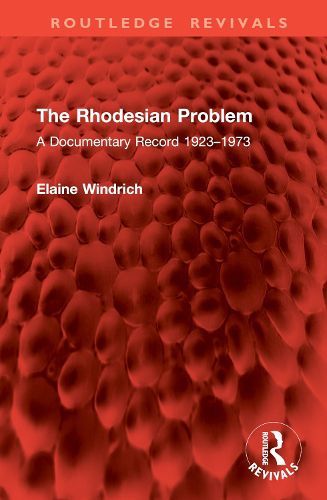Readings Newsletter
Become a Readings Member to make your shopping experience even easier.
Sign in or sign up for free!
You’re not far away from qualifying for FREE standard shipping within Australia
You’ve qualified for FREE standard shipping within Australia
The cart is loading…






First published in 1975, The Rhodesian Problem presents a documentary record of Rhodesia from the establishment of the Crown colony in 1923 to the illegal declaration of independence in 1965 and the post-independence efforts for a settlement of the conflict. The documents chart the gradual development of conflict between the ruling white minority and the black majority. They illustrate the methods adopted by the Smith government to maintain effective power in the face of United Nations and British government sanctions and increasing opposition from the indigenous black population. The main objectives of Rhodesian policy during the period under review were the achievement of independence from Britain; the expansion to the north to create a 'greater Rhodesia' dominion in central Africa, including the wealth of the Copperbelt; and the preservation of a society in which white minority rule was based upon a system of rigid racial segregation.
There are over 60 documents, ranging from the Buxton committee report of 1921 through to an estimate of the contemporary situation by Peter Niesewand, the journalist who was imprisoned by the Smith regime in 1973. They cover many shades of opinion including UN resolutions, official Rhodesian government propaganda, and statements from the African opposition, and the collection provides overall a dramatic account of the Rhodesian problem. This book will be of interest to students and researchers of history and international politics.
$9.00 standard shipping within Australia
FREE standard shipping within Australia for orders over $100.00
Express & International shipping calculated at checkout
First published in 1975, The Rhodesian Problem presents a documentary record of Rhodesia from the establishment of the Crown colony in 1923 to the illegal declaration of independence in 1965 and the post-independence efforts for a settlement of the conflict. The documents chart the gradual development of conflict between the ruling white minority and the black majority. They illustrate the methods adopted by the Smith government to maintain effective power in the face of United Nations and British government sanctions and increasing opposition from the indigenous black population. The main objectives of Rhodesian policy during the period under review were the achievement of independence from Britain; the expansion to the north to create a 'greater Rhodesia' dominion in central Africa, including the wealth of the Copperbelt; and the preservation of a society in which white minority rule was based upon a system of rigid racial segregation.
There are over 60 documents, ranging from the Buxton committee report of 1921 through to an estimate of the contemporary situation by Peter Niesewand, the journalist who was imprisoned by the Smith regime in 1973. They cover many shades of opinion including UN resolutions, official Rhodesian government propaganda, and statements from the African opposition, and the collection provides overall a dramatic account of the Rhodesian problem. This book will be of interest to students and researchers of history and international politics.